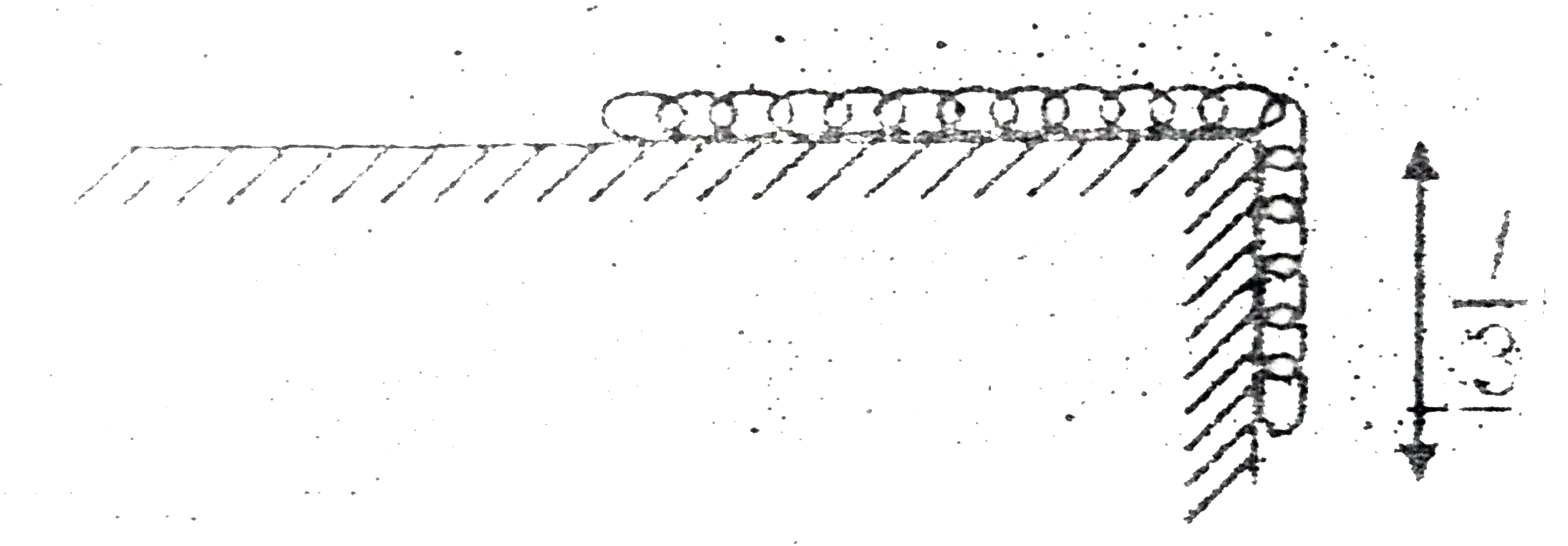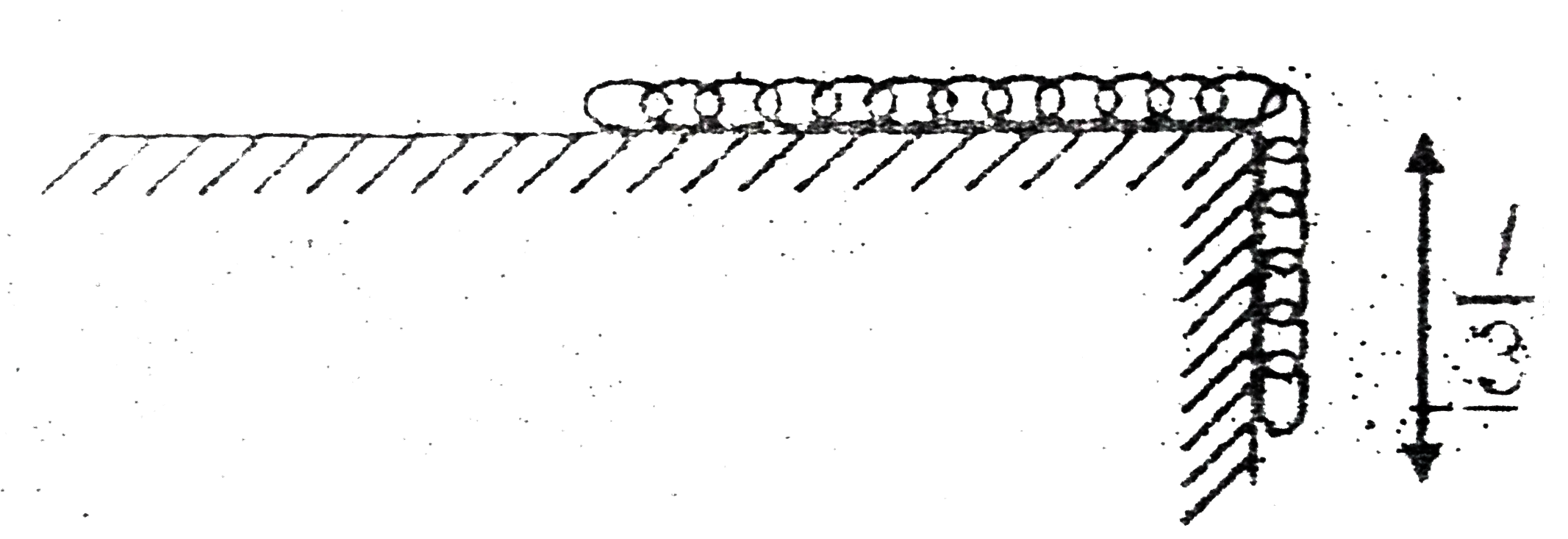A uniform chain of length L lies on a smooth horizontal table with its length perpendicular to the edge of the table and a small portion of the chain is hanging over the edge. The chain starts sliding due to the weight of the hanging part
The acceleration of the chain is (gx/L), where x is the length of the hanging part of chain.
The acceleration of the chain is (g/L)(L−x), where x is the length of hanging part of chain.
The velocity of the chain is x√gL, where x is the length of hanging part of chain.
The velocity of the chain is (L−x)√gL, where x is the length of hanging part of chain.
The correct Answer is:A, C
To solve the problem of a uniform chain of length L lying on a smooth horizontal table with a portion hanging over the edge, we will analyze the forces acting on the chain and derive expressions for both the acceleration and velocity of the hanging part.
1. Define Variables:
- Let the total length of the chain be L.
- Let the length of the chain hanging over the edge at any time t be x.
- The length of the chain on the table will then be L−x.
- Let the total mass of the chain be m.
2. Determine the Mass of the Hanging Portion:
- The mass of the entire chain is m for length L.
- The mass per unit length of the chain is mL.
- Therefore, the mass of the hanging portion x is given by:
mx=mL⋅x
3. Calculate the Weight of the Hanging Portion:
- The weight W of the hanging portion is:
W=mx⋅g=(mL⋅x)⋅g=mgxL
4. Apply Newton's Second Law:
- The net force acting on the hanging portion is equal to the weight of the hanging part, which causes the acceleration a of the chain.
- According to Newton's second law:
F=m⋅a
- Here, the force F is the weight of the hanging part:
mgxL=m⋅a
- Dividing both sides by m:
gxL=a
- Thus, the acceleration a of the hanging part is:
a=gL⋅x
5. Determine the Velocity of the Hanging Part:
- To find the velocity v of the hanging part, we can use the relationship between acceleration and velocity:
a=vdvdx
- Substituting a=gL⋅x:
gL⋅x=vdvdx
- Rearranging gives:
vdv=gL⋅xdx
- Integrating both sides:
∫vdv=∫gL⋅xdx
- This results in:
v22=gL⋅x22+C
- Assuming the initial condition v=0 when x=0, we find C=0:
v2=gL⋅x2
- Therefore, the velocity v of the hanging part is:
v=√gL⋅x
Summary of Results:
- The acceleration of the hanging part is:
a=gL⋅x
- The velocity of the hanging part is:
v=√gL⋅x
- Let the total length of the chain be L.
- Let the length of the chain hanging over the edge at any time t be x.
- The length of the chain on the table will then be L−x.
- Let the total mass of the chain be m.
- The mass of the entire chain is m for length L.
- The mass per unit length of the chain is mL.
- Therefore, the mass of the hanging portion x is given by:
mx=mL⋅x
- The weight W of the hanging portion is:
W=mx⋅g=(mL⋅x)⋅g=mgxL
- The net force acting on the hanging portion is equal to the weight of the hanging part, which causes the acceleration a of the chain.
- According to Newton's second law:
F=m⋅a
- Here, the force F is the weight of the hanging part:
mgxL=m⋅a
- Dividing both sides by m:
gxL=a
- Thus, the acceleration a of the hanging part is:
a=gL⋅x
- To find the velocity v of the hanging part, we can use the relationship between acceleration and velocity:
a=vdvdx
- Substituting a=gL⋅x:
gL⋅x=vdvdx
- Rearranging gives:
vdv=gL⋅xdx
- Integrating both sides:
∫vdv=∫gL⋅xdx
- This results in:
v22=gL⋅x22+C
- Assuming the initial condition v=0 when x=0, we find C=0:
v2=gL⋅x2
- Therefore, the velocity v of the hanging part is:
v=√gL⋅x
- The acceleration of the hanging part is:
a=gL⋅x
- The velocity of the hanging part is:
v=√gL⋅x
Topper's Solved these Questions
- BOOK - FIITJEECHAPTER - LAWS OF MOTIONEXERCISE - COMPREHENSION-III2videos
LAWS OF MOTION
- BOOK - FIITJEECHAPTER - LAWS OF MOTIONEXERCISE - ASSIGNMENT PROBLEMS (OBJECTIVE)(Level-1) (ASSERTION REASONING TYPE)2videos
LAWS OF MOTION
- BOOK - FIITJEECHAPTER - KINEMATICSEXERCISE - NUMERICAL BASED QUESTIONS DECIMAL TYPE5videos
KINEMATICS
- BOOK - FIITJEECHAPTER - MAGNETICEXERCISE - Numerical Based Type2videos
MAGNETIC
Similar Questions
A uniform chain of mass m and length l is lying on a horizontal table with one-third of its length hanging over the edge of the table.

What is the speed of the chain, when it just loses contact with the table?View SolutionA uniform chain of mass m and length l is lying on a horizontal table with one-third of its length hanging over the edge of the table.

If a gentale pull is given to hanging end, it will start moving down. What is the change in gravitational potential energy of the chain, as it jist leaves the table?View Solution
Knowledge Check
- Question 1 - Select One
A uniform rope of length l and mass m lies on a smooth horizontal table with its length perpendicular to the edge of the table and a small part of the rope having over the edge. The rope starts sliding from rest under the weight of the over hanging end. The velocity of the rope when the length of the hanging part is . x
A√gxlB√gx2lCgxlDgx2l - Question 2 - Select One
A uniform chain of length l is placed on a smooth horizontal table, such that half of its length hangs over one edge. It is releasedfrom rest, the velocity with which it leaves the table is
A√3gl4B√3gl2C√2gl3D√gl3 - Question 3 - Select One
A uniform metal chain is placed on a rough table such that the one end of chain hangs down over the edge of the table, when one-third of its length hang over the edge, the chain starts sliding. Then the coefficient of static friction is
A34B14C23D12
A uniform chain of mass m and length l is lying on a horizontal table with one-third of its length hanging over the edge of the table.

If the chain is limiting equlibrium, what is the coefficient of friction for the contact between table and chain?View SolutionA uniform chain of mass m and length l is kept on a horizontal table with half of its length hanging from the edge of the table.Work done in pulling the chain on to the table so that only 1/5 th of its length now hangs from the edge is K(mgl200) .Find the value of K.
View SolutionA uniform chain of length l and mass m overhangs a smooth table with its tow third pat lying on the tabl. Find the kinetic energy of the chain s it completely slips off the table.
View SolutionA uniform chain has mass Mand length L. It is lying on a smooth horizontal table with half of its length hanging vertically downward. The work done in pulling the chain up the table is:
View SolutionA uniform rope of length 'L and linear density 'μ' is on a smooth horizontal table with a length 'I' lying on the table. The wrok done in pulling the hanging part on to the table is
View Solution

